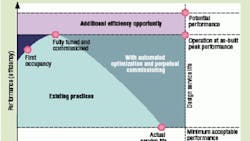Maximizing Stimulus Dollars With BAS
The American Recovery and Reinvestment Act of 2009 (ARRA) promises investments that create jobs and modernize facilities to be more energy efficient, productive, and sustainable. This funding is designed to invigorate neglected infrastructure and construction projects, leveraging the latest technologies. One way to accomplish the ARRA's goal of investing in a sustainable future is to invest in systems that will optimize hundreds of thousands of facilities for decades to come.
THE CASE FOR BAS
By supporting self-tuning and continuous commissioning with intelligent programs, a building automation system (BAS) makes structural elements and mechanical and electrical systems work smarter and longer. Although the incremental investment in automation and control systems usually is less than 2 percent of the cost of new project construction, it can impact operation costs by more than 20 percent.
For example, many ARRA projects will include updates or replacements of old chillers and pumps for chilled-water loops. On their own, these projects provide greater efficiency when installed and commissioned. But with the addition of advanced automation, greater long-term benefits and protection of the initial investment can be ensured. Specifically, installing vibration-analysis transducers at strategic locations on chillers and pumps and receiving continuous automated analysis of recovered information provides desired sustainability benefits.
A new pump with a variable-speed drive will save significant energy dollars, but a motor that is improperly aligned with the pump can negate much of those savings. Although correct alignment should be covered on commissioning checklists, it often is neglected or not optimized. In addition to an energy penalty, incorrect alignment can cause premature bearing failure and result in repair charges. There also is a good chance that these failures may not occur until after the warranty period has expired. By using the information vibration sensors provide, alignment can be verified and installation fine-tuned. The result is a project that meets or exceeds engineered efficiency estimates.
Taking the example one step further, normally, it is good practice to come back and check pumps in six weeks to six months. However, that rarely happens. An automated vibration-analysis program ensures that everything is correct. The benefits do not stop after six months or a year. While it is inevitable that equipment efficiency tends to decrease with age, it is possible to ensure that the decrease is minimal. Continuous performance evaluation is key, but that is impossible without correct instrumentation and the application of automated fault-detection diagnostics. By employing these tuning and maintenance methods, operating costs can be lowered significantly and equipment life can be extended. Just extending the life of a typical piece of mechanical equipment by two years and avoiding efficiency losses can save 12.5 percent on an annual basis, not counting other benefits of automation, such as optimal scheduling (Figure 1).
Therefore, an advanced automation system that is applied correctly can ensure correct “as-built” performance, extend equipment life, and decrease ongoing operational costs. It stands to reason that these same optimization benefits, when applied to chillers and other large pieces of rotational mechanical equipment, are desirable and justify the first cost of the instrumentation.
BAS AND SMART-GRID OPERATION
The benefits of BAS with fault-detection diagnostics are not limited to rotational equipment. Many electrical devices have similar efficiency erosion characteristics that can be attributed to their environments. Making sure these devices are clean, operating at the right temperatures, and in their acceptable humidity range sounds simple. However, it is difficult to do this without the constant automated evaluation provided by automated systems.
Investment in a BAS also can impact the sustainability and long-term efficiency of a project thanks to the effect of the smart grid on the near-future cost of electrical power. Although the major issues regarding smart-grid operation concern the ability to communicate with the grid, it probably will be more costly to implement the technology required to work with the grid. Projects that are instrumented and integrated to the highest levels of building intelligence will reduce these costs.
The smart grid is, after all, an extension of demand-response (DR) programs that are in place in the East and West. The grid uses demand reduction as a substitute for increased generation and, ultimately, additional capacity. The last kilowatt produced usually is the most expensive, while the first kilowatt saved typically is the least painful. As a result, there is significant impetus, as well as financial incentive, to implement a smart-grid system for those willing to guarantee the demand reduction.
On a much larger scale, the smart grid connects energy users to a two-way system that communicates pricing information in one direction and usage patterns in another. Fortunately, high-demand conditions usually occur on the hottest days and are predictable. This ensures an orderly and efficient grid, even in the worst demand conditions. It not only gives us the ability to match supply with demand, it allows us to influence demand as well. In the end, the intelligence of the integrated, intelligent building systems and their ability to respond to pricing and demand-reduction requests is what makes individual buildings more efficient. Smart grids need smart buildings; BAS provide the necessary “smarts.”
CONCLUSION
Investments in efficient mechanical and electrical equipment can be optimized and made sustainable with instrumentation tied to advanced automation techniques, such as fault-detection diagnostics. The facilities and associated equipment purchased with ARRA dollars deserve no less. Investing in infrastructure without investing in intelligent automation does not reflect optimal use of this funding.
Director of marketing for the building-automation-controls division of Johnson Controls Inc., Terry Hoffmann defines and develops materials for new product deployment, strategic brand management, and the identification of technology. He has a bachelor's degree in electrical engineering from Marquette University and a master's degree in engineering management from the Milwaukee School of Engineering, where he serves as an adjunct professor.
